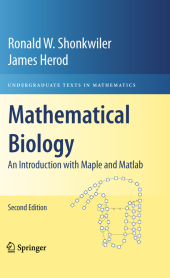 Neuerscheinungen 2014Stand: 2020-02-01 |
Schnellsuche
ISBN/Stichwort/Autor
|
Herderstraße 10
10625 Berlin
Tel.: 030 315 714 16
Fax 030 315 714 14
info@buchspektrum.de |

James Herod, Ronald W. Shonkwiler
(Beteiligte)
Mathematical Biology
An Introduction with Maple and Matlab
2. Aufl. 2014. xiii, 551 S. 35 Tabellen. 235 mm
Verlag/Jahr: SPRINGER, BERLIN; SPRINGER NEW YORK; SPRINGER 2014
ISBN: 1-489-98281-7 (1489982817)
Neue ISBN: 978-1-489-98281-0 (9781489982810)
Preis und Lieferzeit: Bitte klicken
This text presents mathematical biology as a field with a unity of its own, rather than only the intrusion of one science into another. The book focuses on problems of contemporary interest, such as cancer, genetics, and the rapidly growing field of genomics.
Biology is a source of fascination for most scientists, whether their training is in the life sciences or not. In particular, there is a special satisfaction in discovering an understanding of biology in the context of another science like mathematics. For- nately there are plenty of interesting problems (and fun) in biology, and virtually all scienti?c disciplines have become the richer for it. For example, two major journals, MathematicalBiosciences andJournalofMathematicalBiology, have tripled in size since their inceptions 20 25 years ago. More recently, the advent of genomics has spawned whole new ?elds of study in thebiosciences,?eldssuchasproteomics,comparativegenomics,genomicmedicine, pharmacogenomics, and structural genomics among them. These new disciplines are as much mathematical as biological. Thevariousscienceshaveagreatdealtogivetooneanother, buttherearestilltoo many fences separating them. In writing this book we have adopted the philosophy that mathematical biology is not merely the intrusion of one science into another, but that it has a unity of its own, in which both biology and mathematics should be equal, complete, and ?ow smoothly into and out of one another. There is a timeliness in calculating a protocol for administering a drug. Likewise, the signi?cance of bones being sinks for lead accumulation while bonemeal is being sold as a dietary c- cium supplement adds new meaning to mathematics as alifescience. The dynamics of a compartmentalized system are classical; applications to biology can be novel. Exponential and logistic population growths are standard studies; the delay in the increaseofAIDScasesbehindtheincreaseintheHIV-positivepopulationisprovo- tive.
Cells, Signals, Growth, and Populations.- Reproduction and the Drive for Survival.- Interactions Between Organisms and Their Environment.- Age-Dependent Population Structures.- Random Movements in Space and Time.- Neurophysiology.- The Biochemistry of Cells.- Biology, Mathematics, and a Mathematical Biology Laboratory.- Systems and Diseases.- The Biological Disposition of Drugs and Inorganic Toxins.- A Biomathematical Approach to HIV and AIDS.- Parasites and Their Diseases.- Cancer: A Disease of the DNA.- Some Mathematical Tools.- Genomics.- Genetics.- Genomics.- Phylogenetics.
From the reviews of the second edition:
"This is a well conceived introduction into some of the most important fields of biomathematics. It aims mainly at undergraduates in mathematics but will be suitable for students who have passed a one-year course of calculus and some linear algebra. ... Each chapter starts with a biological motivation and an introduction of the basic biology required." (R. Bürger, Monatshefte für Mathematik, Vol. 169 (2), February, 2013)


